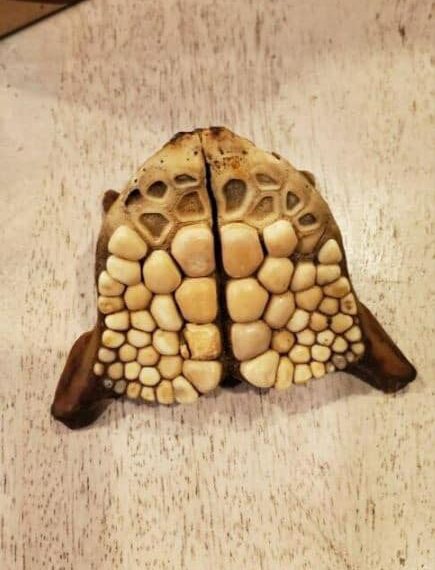If you’ve ever spent time searching the sands of a beach, you know the special thrill of stumbling upon something unusual — a twisted shell, a piece of driftwood shaped like a sculpture, or maybe even a shiny sea glass fragment. But imagine finding something so puzzling that it stops you cold, something strange and toothy that looks like it might have come from a prehistoric creature. That’s exactly what happened to a beachcomber walking the shores of Pensacola, Florida.
For two whole decades, this mysterious find baffled experts and enthusiasts alike. Marine biologists puzzled over it, museum curators scratched their heads, and no one could quite say what the odd object was. It looked like a fossil, but no one could place it. The mystery remained unsolved — until recently.
The Discovery: A Tooth-Like Mystery on a Gulf Coast Beach
It all began with a casual stroll on the beach. The beachcomber noticed a strange object half-buried in the sand — it looked toothy and somewhat fossilized, like something that belonged to an ancient sea creature. The curiosity was immediate.
What was this? A piece of coral? A strange fossilized shell? Some kind of prehistoric shark tooth? The internet buzzed with speculation as photos circulated on Reddit and other forums. Yet no clear answers emerged.
Experts from marine biology and paleontology fields examined the object but remained stumped. Its unique shape, texture, and structure did not match any common fossil or marine remnant known to the region.
Finally, the Truth Revealed: Freshwater Drum “Pharyngeal Teeth”
After years of mystery and investigation, the object was finally identified for what it truly was: pharyngeal teeth from a freshwater drum fish (Aplodinotus grunniens), sometimes simply called a “drum.”
But what exactly are pharyngeal teeth, and why would they look so strange?
Unlike typical fish that have rows of sharp teeth inside their mouths, freshwater drum fish possess a very different type of teeth — located not in the mouth, but deep in their throat. These are called pharyngeal teeth, and they function as powerful grinding tools, rather like molars in mammals. They help the fish crush hard-shelled prey such as clams, snails, and mussels.
In other words, these aren’t teeth for biting or tearing, but for crushing and grinding — a key evolutionary adaptation that allows freshwater drum to exploit food sources other fish can’t.
Why Are These Teeth So Unique and Confusing?
The pharyngeal teeth of freshwater drums are densely packed and arranged in a mosaic-like pattern, sometimes resembling fossilized coral or an intricate stone artifact. This unusual appearance is part of what made the object so baffling for so long.
When washed up on a beach, these teeth look like they could be ancient relics from the ocean’s depths, rather than remnants of a modern fish species.
It’s easy to see why someone might assume this was a fossil or something prehistoric. The oddly beautiful pattern and solid, almost mineralized texture made it seem like a museum specimen — until modern science stepped in to explain the mystery.
How Did Freshwater Fish Teeth End Up on a Saltwater Beach?
One of the most puzzling aspects of this discovery is the location — the Gulf Coast of Florida, where saltwater beaches are the norm. Freshwater drum fish usually inhabit rivers, lakes, and freshwater systems across much of North America. So how did their throat teeth get all the way to a salty beach?
The answer lies in the ecological versatility of the freshwater drum.
These fish can survive in brackish waters — environments where saltwater and freshwater mix, such as estuaries and river mouths. This adaptability means they sometimes venture into coastal areas where fresh and saltwater overlap.
It’s entirely plausible that a freshwater drum’s remains were carried by ocean currents or tidal flows from an estuary into the Gulf of Mexico. Over time, parts like the pharyngeal teeth might detach and wash ashore, where the beachcomber eventually found them.
Nature’s Ingenious Adaptation: The Role of Pharyngeal Teeth in Freshwater Drum Survival
The pharyngeal teeth of freshwater drum fish are more than just curiosities — they represent an incredible example of nature’s adaptability.
By evolving molar-like grinders, these fish can feed on hard prey that other species can’t access. Clams, snails, and mussels become possible meals, giving freshwater drum an ecological niche that helps keep aquatic ecosystems balanced.
This feeding strategy benefits freshwater systems by controlling populations of shelled invertebrates, maintaining biodiversity and contributing to the health of lakes and rivers.
What This Discovery Teaches Us About Evolution and Ecology
The resolution of this 20-year mystery isn’t just about identifying a strange object on a beach. It offers us a window into evolutionary adaptation, environmental dynamics, and the interconnectedness of aquatic life.
The pharyngeal teeth are a tangible reminder of how animals can evolve specialized tools to survive and thrive. It’s a small but powerful example of evolutionary innovation — a fish developing throat grinders instead of typical teeth to exploit unique food sources.
Moreover, it highlights the complex relationships between freshwater and saltwater ecosystems. The movement of species, remains, and nutrients between these habitats shapes coastal biodiversity in ways we’re still learning to understand.
What to Do If You Find Something Strange on the Beach
If you’re a beachcomber or casual wanderer who spots an odd or unfamiliar object in the sand, remember that nature is full of surprises. You might be looking at:
- Fossilized remains
- Unique shells or coral formations
- Parts of modern animals that look ancient or mysterious
- Human-made artifacts that have weathered the elements
Before jumping to conclusions, consider sharing photos on science forums, social media, or with local natural history museums. Many mysteries have been solved thanks to the curiosity and collaboration of everyday people and experts.
Final Thoughts: The Magic of a 20-Year Mystery Solved
The story of the freshwater drum’s pharyngeal teeth found on a Florida beach is a testament to the power of curiosity, patience, and scientific inquiry.
What began as a puzzling beach find became an opportunity to appreciate nature’s ingenuity and the rich tapestry of life that surrounds us — often hidden in plain sight.





